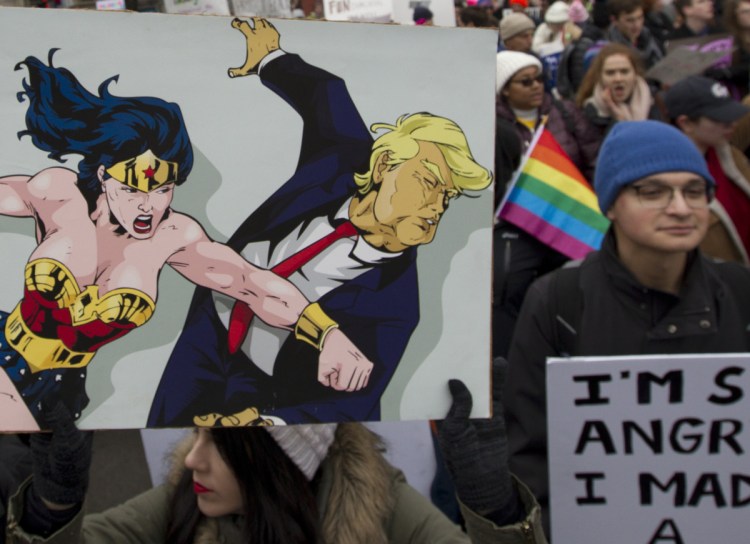WASHINGTON — Amid internal controversies and a capital city deeply distracted by the partial government shutdown, the third Women’s March returned to Washington on Saturday with an enduring message of anger and defiance aimed directly at President Trump’s White House.
The original march in 2017, the day after Trump’s inauguration, flooded the city with hundreds of thousands of people. The exact size of the turnout remains subject to a politically charged debate, but it’s generally regarded as the largest Washington protest since the Vietnam era.
This year was a more modest affair for multiple reasons. An estimated 100,000 protesters packed several blocks around Freedom Plaza, just east of the White House, holding a daylong rally. The march itself took about an hour and only moved about four blocks west along Pennsylvania Avenue past the Trump International Hotel before looping back to Freedom Plaza.
The original plan was to gather on the National Mall. But with the forecast calling for snow and freezing rain and the National Park Service no longer plowing snow because of the shutdown, organizers on Thursday changed the march’s location and route.
As it turned out the weather was chilly but otherwise pleasant, and the mood among the marchers a now-familiar mix of sister-power camaraderie and defiant anger toward Trump and the larger power structure.
One sign declared, “Strong women only fear weak men.” Another stated, “MOOD: Still pretty mad about Kavanaugh.”
Parallel marches took place in dozens of cities around the country.
Preparations for this year’s march were roiled by an intense ideological debate among the movement’s senior leadership. In November, Teresa Shook, one of the movement’s founders, accused the four main leaders of the national march organization of anti-Semitism.
The accusation was leveled at two primary leaders: Linda Sarsour, a Palestinian-American who has criticized Israeli policy, and Tamika Mallory, who has maintained an association with Nation of Islam leader Louis Farrakhan.
Shook, a retired lawyer from Hawaii, has been credited with sparking the movement by creating a Facebook event that went viral and snowballed into the massive protest on Jan. 21, 2017. In a recent Facebook post, she claimed Sarsour and Mallory, along with fellow organizers Bob Bland and Carmen Perez, had “steered the Movement away from its true course” and called for all four to step down.
The four march organizers have denied the charge, but Sarsour has publicly expressed regret that they were not “faster and clearer in helping people understand our values.”
Despite pleas for unity, an alternate women’s march organization sprung up in protest and a parallel rally took place in New York a few miles away from the official New York Women’s March protest.
Copy the Story LinkSend questions/comments to the editors.



Success. Please wait for the page to reload. If the page does not reload within 5 seconds, please refresh the page.
Enter your email and password to access comments.
Hi, to comment on stories you must . This profile is in addition to your subscription and website login.
Already have a commenting profile? .
Invalid username/password.
Please check your email to confirm and complete your registration.
Only subscribers are eligible to post comments. Please subscribe or login first for digital access. Here’s why.
Use the form below to reset your password. When you've submitted your account email, we will send an email with a reset code.